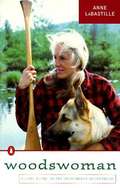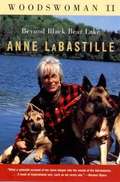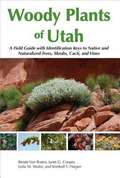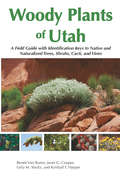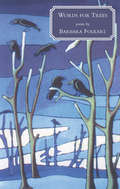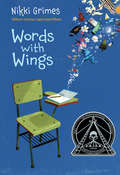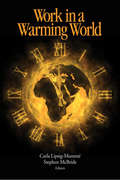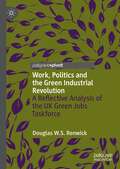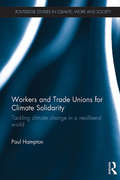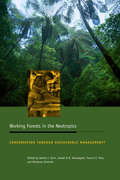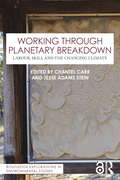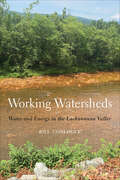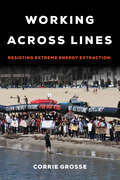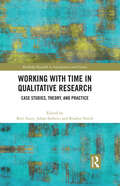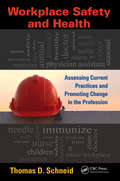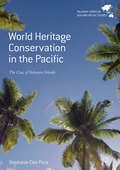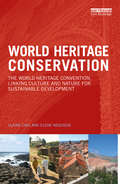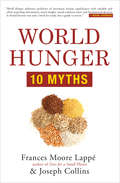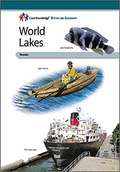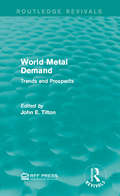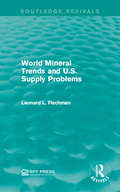- Table View
- List View
Woodswoman
by Anne LabastilleA charming memoir in which the author tells about building her own log cabin, surviving harsh winters, living affably with nature, and thoroughly enjoying and beautifully describing this part of her life.
Woodswoman II: Beyond Black Bear Lake
by Anne LaBastilleAnne LaBastille found peace and solitude in the log cabin she built for herself at Black Bear Lake. But as the years passed, the outside world intruded in various ways: curious fans, after reading her best-selling book Woodswoman, tracked her down; land developers arrived; there was air and noise pollution and the damages of acid rain. Woodswoman II is the story of the author's decision to retreat farther, a half-mile behind her main cabin, and build a tiny cabin―fashioned after the one in Thoreau's Walden―in which she could write and contemplate. In this book (originally published under the title Beyond Black Bear Lake) she writes movingly of her life with two German shepherds as companions, of a sustaining relationship with a man as independent as herself, and her renewed bond with nature.
Woodwork Projects for Your Garden and Porch: Simple, Functional, and Rustic Décor You Can Build Yourself
by Malin Nuhma Mattias WenbladGive your garden a unique, do-it-yourself charm with practical and decorative woodwork projects.Do you have a bare, uninspired garden or porch? Instead of overhauling and reconstructing the entire design, simply transform it with twenty-six essential and practical woodwork projects that will provide your home with a dash of DIY, rustic charm.These easy, fun, and attractive wood creations are accompanied by clear, step-by-step instructions and photographs and are divided into projects for planting and growing and for socializing and relaxing, as well as fun items for children. Woodwork Projects for Your Garden and Porch will have you making elegant, yet functional, pieces, such as: Benches and long tables Swings and trellises Flower boxes and driftwood shelves A mini outdoor kitchen and greenhouse And many more!Invest energy and love into your garden and porch and turn it into a personal oasis where you can unwind with a cup of coffee and a book, work on your gardening, or play games with the kids using the wooden pieces you have constructed with your own hands.
Woody Plants of Utah
by Leila M. Shultz Kimball T. Harper Renée Van Buren Janet G. CooperA comprehensive guide that includes a vast range of species and plant communities and employs thorough, original keys. Based primarily on vegetative characteristics, the keys don't require that flowers or other reproductive features be present, like many plant guides. And this guide's attention to woody plants as a whole allows one to identify a much greater variety of plants. That especially suits an arid region such as Utah with less diverse native trees. Woody plants are those that have stems that persist above ground even through seasons that don't favor growth, due to low precipitation or temperatures. Woody Plants of Utah employs dichotomous identification keys that are comparable to a game of twenty questions. They work through a process of elimination by choosing sequential alternatives. Detailed, illustrated plant descriptions complement the keys and provide additional botanical and environmental information in relation to a useful introductory categorization of Utah plant communities. Supplementary tools include photos, distribution maps, and an illustrated glossary.
Woody Plants of Utah: A Field Guide with Identification Keys to Native and Naturalized Trees, Shrubs, Cacti, and Vines
by Leila M. Shultz Kimball T. Harper Janet G. Cooper Renee Van BurenA comprehensive guide that includes a vast range of species and plant communities and employs thorough, original keys. Based primarily on vegetative characteristics, the keys don't require that flowers or other reproductive features be present, like many plant guides. And this guide's attention to woody plants as a whole allows one to identify a much greater variety of plants. That especially suits an arid region such as Utah with less diverse native trees. Woody plants are those that have stems that persist above ground even through seasons that don't favor growth, due to low precipitation or temperatures. Woody Plants of Utah employs dichotomous identification keys that are comparable to a game of twenty questions. They work through a process of elimination by choosing sequential alternatives. Detailed, illustrated plant descriptions complement the keys and provide additional botanical and environmental information in relation to a useful introductory categorization of Utah plant communities. Supplementary tools include photos, distribution maps, and an illustrated glossary.
Words for Trees
by Barbara FolkartIn this Ottawa writer’s first volume of verse, there are trees, of coursecatalpas on stained-glass transoms, an ever-present crabappel, nameless species in whose bare branches the winter solstice lurks. There is music, tooa whorehouse tango, a string quartet enthralling a favourite cat, the silky caress of a clarinet along the remembered flesh of adolescence. And visual art, from the Middle Ages through Matisse, is reenacted in vignettes of desire or dereliction.
Words with Wings
by Nikki GrimesGaby daydreams to tune out her parents' arguments, but when her parents divorce and she begins a new school, daydreaming gets her into trouble. Her mother scolds her for it, her teacher keeps telling her to pay attention, and the other kids tease her...until she finds a friend who also daydreams and her teacher decides to work a daydreaming-writing session into every school day. With a notebook "thick with daydreams," Gaby grows more confident about herself and her future. This verse novel poignantly celebrates the power of writing and the inspiration a good teacher can deliver.
Work in a Warming World
by Stephen Mcbride Carla Lipsig-MumméGlobal warming is perhaps the greatest challenge facing the twenty-first century. Environmental polices on the one hand, and economic and labour market polices on the other, often exist in separate silos creating a dilemma that Work in a Warming World confronts. The world of work - goods, services, and resources - produces most of the greenhouse gases created by human activity. In engaging essays, contributors demonstrate how the world of work and the labour movement need to become involved in the struggle to slow global warming, and the ways in which environmental and economic policies need to be linked dynamically in order to effect positive change. Addressing the dichotomy of competing public policies in a Canadian context, Work in a Warming World presents ways of creating an effective response to global warming and key building blocks toward a national climate strategy.
Work in a Warming World (Queen's Policy Studies Series #184)
by Carla Lipsig-Mummé Stephen McBrideGlobal warming is perhaps the greatest challenge facing the twenty-first century. Environmental polices on the one hand, and economic and labour market polices on the other, often exist in separate silos creating a dilemma that Work in a Warming World confronts. The world of work - goods, services, and resources - produces most of the greenhouse gases created by human activity. In engaging essays, contributors demonstrate how the world of work and the labour movement need to become involved in the struggle to slow global warming, and the ways in which environmental and economic policies need to be linked dynamically in order to effect positive change. Addressing the dichotomy of competing public policies in a Canadian context, Work in a Warming World presents ways of creating an effective response to global warming and key building blocks toward a national climate strategy.
Work, Politics and the Green Industrial Revolution: A Reflective Analysis of the UK Green Jobs Taskforce
by Douglas W.S. RenwickIn 2020, UK Prime Minister Boris Johnson launched The Green Jobs Taskforce, which extended and articulated the green jobs policy of his government and its position within conservative political ideology. This book critically highlights gaps in the political and business decision-making of his Taskforce, most notably on: the limited role of employers and HRM associations in skills building for staff in non-polluter industries (solar and wind); issues of a fair and just transition for workers losing jobs in the polluter industries (fossil fuels); and the lack of employee voice in both work arenas. The overtly pro-conservative and political nature of this UK Taskforce is also analyzed, which occurs and operates in opposition to British trade unions and the wider labor movement, by not prioritizing the just transition, alongside the extensive skills, training and passporting requirements that British workers need to gain decent, green jobs.This book is distinctive in offering the first in-depth analysis and critique of the UK Green Jobs Taskforce, in examining this Taskforce using conservative political ideas, and by critiquing it too. Little academic literature is available globally on the business impact and analysis of UK governmental sustainability policy, and this study can provide wider learning points, lessons and implications for other green job plans being formed and enacted in the EU, USA and other countries. It will be of great interest to academics and students of sustainability, HRM, organizational behavior, organization studies and employment relations.
Workers and Trade Unions for Climate Solidarity: Tackling climate change in a neoliberal world (Routledge Studies in Climate, Work and Society)
by Paul HamptonThis book is a theoretically rich and empirically grounded account of UK trade union engagement with climate change over the last three decades. It offers a rigorous critique of the mainstream neoliberal and ecological modernisation approaches, extending the concepts of Marxist social and employment relations theory to the climate realm. The book applies insights from employment relations to the political economy of climate change, developing a model for understanding trade union behaviour over climate matters. The strong interdisciplinary approach draws together lessons from both physical and social science, providing an original empirical investigation into the climate politics of the UK trade union movement from high level officials down to workplace climate representatives, from issues of climate jobs to workers’ climate action. This book will be of great interest to students and researchers in environmental politics, climate change and environmental sociology.
Working Childhoods
by Jane DysonWorking Childhoods draws upon research in the Indian Himalayas to provide a theoretically-informed account of children's lives in a remote part of the world. The book shows that children in their pre-teens and teens are lynchpins of the rural economy, spending hours each day herding cattle, collecting leaves, and juggling household tasks with schoolwork. Through documenting in painstaking detail children's stories, songs, friendships, fears and tribulations, the book offers a powerful account of youth agency and young people's rich relationship with the natural world. The 'environment' emerges not only as a crucial economic resource but also as a basis for developing gendered ideas of self. The book should be essential reading for anyone interested in better understanding childhood, youth, the environment, and development within and beyond India - including anthropologists, sociologists, geographers, development studies scholars, and South Asianists.
Working Forests in the Neotropics: Conservation Through Sustainable Management? (Biology and Resource Management Series)
by Daniel J. Janaki R. R. Alavalapati Frances E. Putz Marianne C. Schmink Eds. ZarinNeotropical forests sustain a wealth of biodiversity, provide a wide range of ecosystem services and products, and support the livelihoods of millions of people. But is forest management a viable conservation strategy in the tropics? Supporters of sustainable forest management have promoted it as a solution to problems of both biodiversity protection and economic stagnation. Detractors insist that any conservation strategy short of fully protected status is a waste of resources and that forest management actually hastens deforestation. By focusing on a set of critical issues and case studies, this book explores the territory between these positions, highlighting the major factors that contribute to or detract from the chances of achieving forest conservation through sustainable management.
Working Through Planetary Breakdown: Labour, Skill and the Changing Climate (Routledge Explorations in Environmental Studies)
by Jesse Adams Stein Chantel CarrThis book offers a genuinely interdisciplinary engagement with the future of paid and unpaid work in the context of the twin challenges of decarbonisation and the growing impacts of an unstable climate.It is innovative in its grounding of such discussions in the everyday realities of workers’ experiences with an empirical focus on skill, occupational shifts and technological change at the workplace level. Part I: Skills and Training delves into how workers gain crucial skills across their lifetimes. From survivalist “preppers” to local microgrid operators, the chapters reveal practical and often unrecognised but essential expertise. Case studies include air-conditioning technical educators and construction trades leveraging tacit knowledge of sustainable practices. Part II: Industrial Transformation draws on empirical studies from coal mining, manufacturing, defence and construction to highlight workers’ experiences of climate shifts, heat and industrial transition. Theoretical contributions explore novel legal strategies such as fossil fuel “cessation” and examine the role of health and safety frameworks in addressing worker democracy and climate-change mitigation.This collection will resonate with scholars, students, policymakers and trade unionists interested in environmental labour studies, just transitions and the future of work. It offers vital lessons for navigating complex industrial transformations.Key features: Detailed case studies in critical sectors such as energy, construction, defence and manufacturing; A dynamic interdisciplinary fusion of human geography, political economy, sociology, industrial relations and law; Emphasis on worker agency, practical skill and grassroots adaptability amid intensifying climate impacts.
Working Watersheds: Water and Energy in the Lackawanna Valley
by William ConlogueA personal narrative, an examination of literary texts, and a history of the Lackawanna Valley region, Bill Conlogue’s Working Watersheds explores how water has circulated in the former anthracite capital of the world. Conlogue not only recounts water’s use in anthracite mining and textile making, but also investigates its resulting pollution. He delves into the current natural gas boom, which threatens groundwater, and concludes with hopes of environmental renewal and restoration. Offering a fresh way to think about the Anthropocene, this distinctive history of water and coal in the Lackawanna Valley discusses how both water abundance and scarcity might play out as global temperatures rise. Working Watersheds is designed to trigger debates about the nature of history, the significance of literature, and the importance of linking person, place, and planet in an era of climate change.
Working across Lines: Resisting Extreme Energy Extraction
by Corrie GrosseHow are communities uniting against fracking and tar sands to change our energy future? Working across Lines offers a detailed comparative analysis of climate justice coalitions in California and Idaho—two states with distinct fossil fuel histories, environmental contexts, and political cultures. Drawing on ethnographic evidence from 106 in-depth interviews and three years of participant observation, Corrie Grosse investigates the ways people build effective energy justice coalitions across differences in political views, race and ethnicity, age, and strategic preferences. This book argues for four practices that are critical for movement building: focusing on core values of justice, accountability, and integrity; identifying the roots of injustice; cultivating relationships among activists; and welcoming difference. In focusing on coalitions related to energy and climate justice, Grosse provides important models for bridging divides to reach common goals. These lessons are more relevant than ever.
Working with Time in Qualitative Research: Case Studies, Theory and Practice (Routledge Research in Anticipation and Futures)
by Keri FacerThis volume creates a conversation between researchers who are actively exploring how working with and reflecting upon time and temporality in the research process can generate new accounts and understandings of social and cultural phenomena and bring new ways of knowing and being into existence. The book makes a significant contribution to the enhancement of the social sciences and humanities by charting research methods that link reflectively articulate notions of time to knowledge production in these areas. Contributors explore how researchers are beginning to adopt tactics such as time visibility, hacking time, making time, witnessing temporal power and caring for temporal disruptions as resources for qualitative research. The book collects fields as disparate as futures studies and history, literary analysis and urban design, utopian studies, and science and technology studies, bringing together those who are working with temporality reflexively as a powerful epistemological tool for scholarship and research inquiry. It surfaces and foregrounds the methodological challenges and possibilities raised. In so doing, this collection will serve as a resource for both new and experienced researchers in the humanities and social sciences, seeking to understand the tools that are emerging, both theoretical and methodological, for working with time as part of research design. This book will be of great interest to students and scholars of research methods, time and temporality, future studies, and the environmental humanities.
Workplace Safety and Health: Assessing Current Practices and Promoting Change in the Profession (Occupational Safety & Health Guide Series)
by Thomas D. SchneidAre the tried and true safety practices still effective in the changing workplace? Is there a better way of safeguarding employees from accidents and injuries? In short, why do you perform the safety activities that you do on a daily basis and do they produce the results necessary to keep your safety program and your company competitive in the global market? Answering these questions and more, Workplace Safety and Health: Assessing Current Practices and Promoting Change in the Profession analyzes the current practices and identifies emerging issues and challenges in the safety and health profession.We Need a Game Changer … A New Way of Achieving a Safe and Healthful WorkplaceSafety pioneer and educator Thomas Schneid makes a strong case that mandatory compliance with OSHA regulations is only the first step in a safety program. And that, due to globalization and the current emphasis on sustainability, the requirements of the safety profession have changed. He explores new sources of information and guidance for addressing the new and emerging issues created by the current economic situation, globalization, and the changing workplace. He also identifies and analyzes emerging ethical issues within the safety and health profession, then suggests potential solutions.Schneid then examines the basic assumptions and challenges you to assess and evaluate your activities in search of a better and more effective way of achieving the results necessary to be competitive in today’s workplace. Taking a provocative look at the current issues facing the safety profession, he shows you how to view safety activities and actions from a different perspective and see the real impact they have on the lives of others. He gives you the tools you need to go beyond OSHA compliance and develop safety programs that will be effective in the global workplace and create and maintain a safe workplace that eliminates all injuries and illnesses.
World Heritage Benefits Beyond Borders
by Amareswar GallaPublished on the 40th anniversary of the World Heritage Convention, this thematic collection of case studies provides a thorough understanding of World Heritage sites and their Outstanding Universal Value in the context of sustainable development. The case studies describe twenty six thematically, typologically and regionally diverse World Heritage sites illustrating their benefits to local communities and ecosystems and sharing the lessons learned with the diverse range of stakeholders involved. The volume emphasises a holistic and integrated view of World Heritage, linking it to the role local communities play in management and protection, and to issues of ecosystem sustainability, and the maintenance of biological, linguistic and cultural diversity. Cross-disciplinary in its scope, this book will provide a meeting point for researchers, practitioners, community representatives and the wider public and will promote cultural and natural heritage conservation as a key vector of sustainable development and social cohesion.
World Heritage Conservation in the Pacific: The Case of Solomon Islands (Palgrave Series in Asia and Pacific Studies)
by Stephanie Clair PriceThis book explores the opportunities and challenges associated with the legal protection of World Heritage sites in the Pacific Islands. It argues that the small Pacific representation on the World Heritage List is in part due to a lack of strong legal frameworks for heritage conservation, putting such sites under threat. Providing a comprehensive analysis of the nomination, listing and protection of the Solomon Island World Heritage Site, it examines the implementation of the World Heritage Convention in the Pacific context. It explores how the international community’s broadening interpretation of the notion of ‘outstanding universal value’ has increased the potential for Pacific heritage to be classified as ‘World Heritage’. This book also analyses the protection regime established by the Convention, and the World Heritage Committee’s approach to heritage conservation, identifying challenges associated with the protection of Pacific Island heritage.
World Heritage Conservation: The World Heritage Convention, Linking Culture and Nature for Sustainable Development
by Claire Cave Elene NegussieThe UNESCO World Heritage Convention has become one of the most successful UN instruments for promoting cultural diplomacy and dialogue on conservation of cultural and natural heritage. This book provides an overview of the convention through an interdisciplinary approach to conservation. It shows that based on the notion of outstanding universal value and international cooperation for the protection of heritage, the convention provides a platform for sustainable development through the conservation and management of heritage of significance to humanity. With increasing globalization of heritage, World Heritage Conservation is reviewed as an emerging interdisciplinary field of study creating new opportunities for inclusive heritage debate both locally and globally, requiring common tools and understanding. With over a thousand properties inscribed on the World Heritage List, from biologically diverse sites such as the Central Amazon Conservation Complex to the urban landscape of the metropolis of Rio de Janeiro, the book will help students, researchers and professionals in the identification, protection, conservation and presentation of World Heritage. Targeted at a diversity of disciplines, the book critically describes the strategies for implementing the convention and the processes of heritage governance for sustainable development.
World Hunger: 10 Myths
by Joseph Collins Frances Moore LappéFrom bestselling authors Frances Moore Lappé and Joseph Collins comes the 21st century’s definitive book on world hunger. Driven by the question, "Why hunger despite an abundance of food?" Lappé and Collins refute the myths that prevent us from addressing the root causes of hunger across the globe. World Hunger: Ten Myths draws on extensive new research to offer fresh, often startling, insights about tough questions-from climate change and population growth to genetically modified organisms (GMOs) and the role of U.S. foreign aid, and more.Brimming with little-known but life-changing examples of solutions to hunger worldwide, this myth-busting book argues that sustainable agriculture can feed the world, that we can end nutritional deprivation affecting one-quarter of the world’s people, and that most in the Global North have more in common with hungry people than they thought. For novices and scholars alike, World Hunger: Ten Myths will inspire a whole new generation of hunger-fighters.
World Lakes (Core Knowledge History and Geography)
by Core Knowledge FoundationWORLD LAKES begins with a review of map skills and geographical terms. Students learn about the benefits and resources provided by lakes, including, in Asia, the Caspian and Aral Seas; in Africa, Lakes Victoria, Tanganyika, and Chad; in South America, Lakes Maracaibo and Titicaca; and, in North America, Lakes Superior, Huron, Michigan, Erie, and Ontario.
World Metal Demand: Trends and Prospects (Routledge Revivals)
by John E. TiltonIn the early 1970s, the post-World War II boom in world metal consumption came to a halt. As time passed, it became clear that what many first thought to be a cyclical downturn was instead a long-term, substantial decline in world metal demand. In this volume, first published in 1990, editor John E. Tilton and four fellow scholars of mineral economics analyse the causes and consequences of this decline and the prospects for future growth in world metal demand. This book will be of interest to students of business and environmental studies.
World Mineral Trends and U.S. Supply Problems (Routledge Revivals)
by Leonard L. FischmanEven though the United States relies heavily on imports for many non-fuel minerals, mineral supply has played only a small role in foreign policy since World War II. Originally published in 1980, this report investigates seven major non-fuel minerals in relation to long-term potential supply and price problems and any short-term issues that may arise to put concerns about supply in perspective for policy-makers. This title will be of interest to students of Environmental Studies and professionals.
